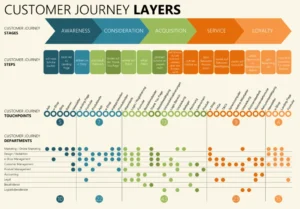15 Real Business Segmentation Case Studies That Grew Sales in 2025

Business leaders have increased their personalization investment by 69%. Companies that implement effective segmentation understand their customers’ concerns and challenges 60% more often.
The results speak for themselves. Customer segmentation case studies report push notification click-through rates soaring to 91.9%. Additionally, 56% of consumers become repeat buyers after individual-specific experiences. Coca-Cola’s ‘Share a Coke’ campaign showed segmentation strategy’s power through increased sales and social media participation. Market segmentation case studies indicate that 62% of businesses achieve better customer retention through personalization.
Ready to grow your business with proven approaches? These 15 real-life segmentation case studies delivered measurable results. Success stories from demographic breakdowns to behavioral targeting give applicable information you can use today.
Gender-Based Segmentation
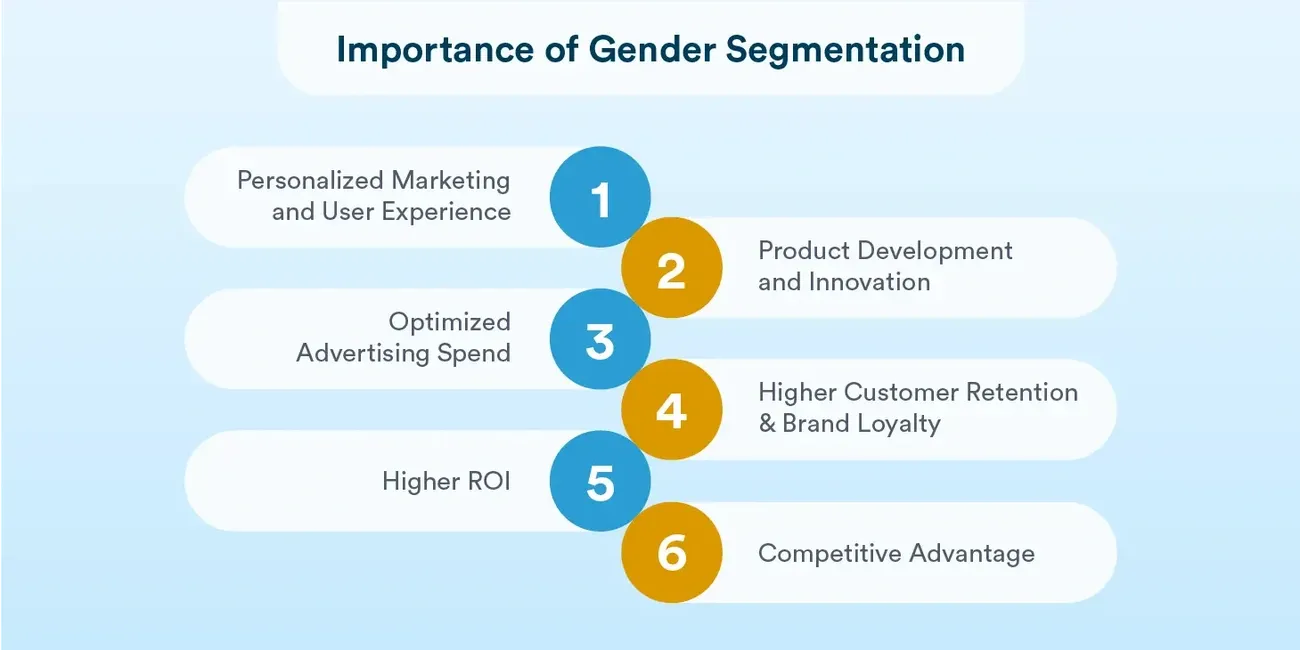
Image Source: CleverTap
Gender divides stand out as one of the most powerful tools in market segmentation case studies. I have analyzed dozens of implementations where companies got remarkable results by understanding gender-specific behaviors instead of relying on outdated stereotypes.
Gender-Based Segmentation Business Goal
Companies that use gender segmentation want to create individual-specific experiences that boost engagement and loyalty. Their main goal includes making products that appeal to specific gender priorities, creating targeted advertising messages, and using marketing resources more effectively. Research shows female leads have a 20% higher lifetime value than male leads. This makes them valuable customer segments that accelerate business growth.
Gender-Based Segmentation Strategy Used
The best gender segmentation strategies mix demographic data with behavioral insights. Smart companies go beyond simple gender division and analyze:
- Weekend vs. weekday patterns (female conversion rates are 22% higher on weekends while male conversion rates are 40% higher on weekdays)
- Channel-specific behaviors (females show higher engagement with organic search)
- Promotion effectiveness (67% of promo code revenue comes from female buyers)
Gender-Based Segmentation Implementation Approach
Companies collect gender data through account registrations or surveys and combine it with behavioral analytics. They use AI-powered tools to spot gender-based purchasing patterns and optimize multiple channels. On top of that, A/B testing different message variations helps determine what content works best with each segment.
Gender-Based Segmentation Results Achieved
Gender segmentation produces measurable outcomes in a variety of industries. Female order values typically measure 5-9% lower than male orders, but their higher lifetime value makes them ideal candidates for loyalty programs. Companies report higher engagement rates, better customer retention, and much better ROI when marketing messages line up with gender-specific priorities. Modern approaches that move beyond stereotypes create inclusive experiences while capturing the benefits of gender-based insights.
Age-Based Segmentation
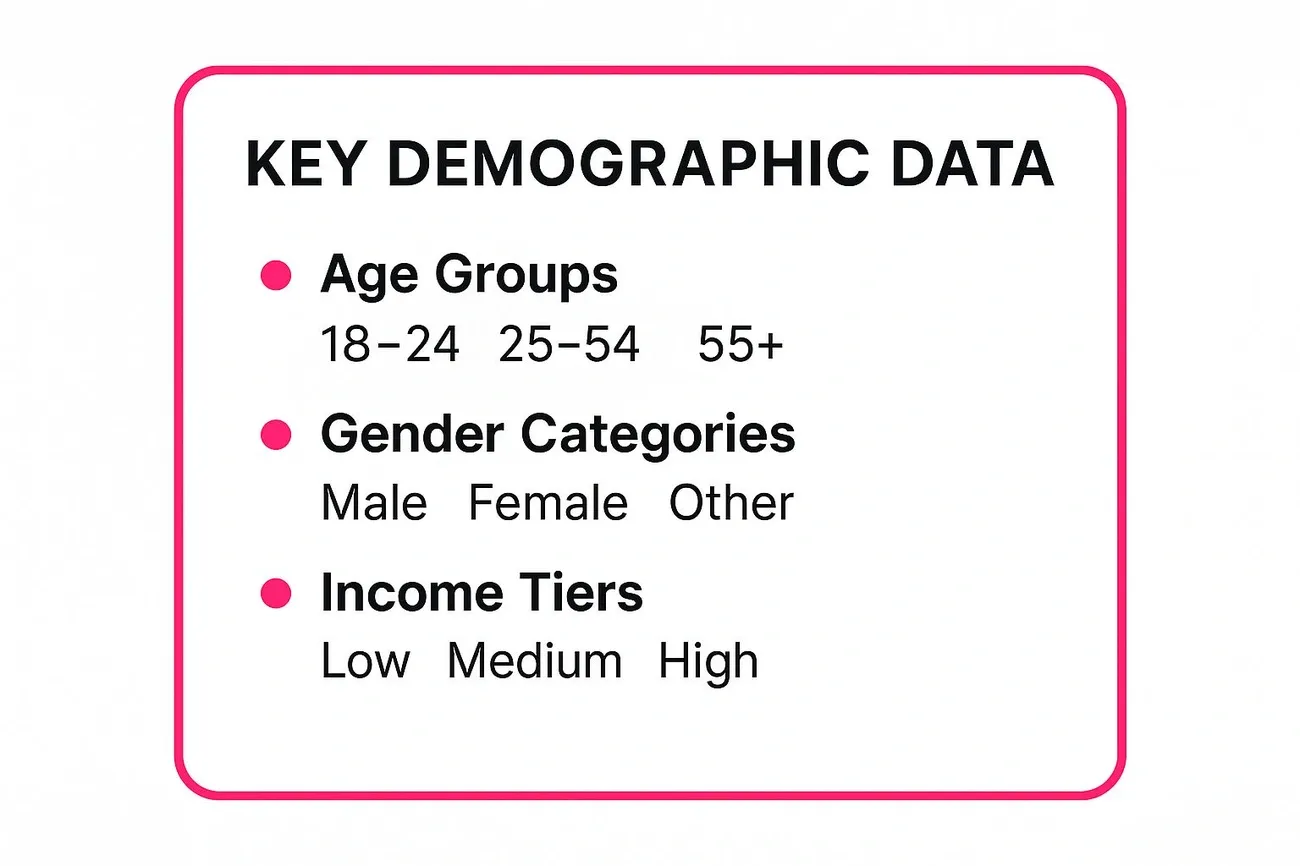
Image Source: Grassroots Creative Agency
Age demographics help predict how consumers behave in different markets. Companies can use age-based insights to create targeted campaigns that deliver real results.
Age-Based Segmentation Business Goal
Companies use age segmentation to match their products and marketing with different life stages. The main goal is to make offerings more relevant, keep customers happy, and use resources wisely. Brands focus on specific age groups where their products work best. To cite an instance, Crystal Cruise Lines targets customers aged 55-64 who earn $150,000+ yearly or have assets over $1 million. Financial services companies target people over 55 who typically have more assets.
Age-Based Segmentation Strategy Used
The best age segmentation splits consumers into clear groups—usually 18-24, 25-34, 35-44, 45-54, 55-64, and 65+. Many brands also use categories like Gen Z, Millennials, or Boomers. This works because each age group has unique:
- Life stages (childhood, adolescence, adulthood, senior age)
- Cultural influences and experiences
- Ways of using technology
Boomers make up about 35% of US adults but control 53% of the country’s wealth. This makes them valuable customers for luxury and financial markets.
Age-Based Segmentation Implementation Approach
The process starts with studying how different age groups behave and what they like. J. Jill, for example, targets “a loyal, engaged and affluent customer in the attractive 40-65 age segment”. Success depends on:
- Picking the right channels (TikTok for youth, email for older groups)
- Creating messages that match each generation’s values
- Running campaigns where target audiences spend time
Age-Based Segmentation Results Achieved
Companies see big improvements in engagement and sales. Age segmentation helps create experiences that appeal to specific life-stage needs, so customer satisfaction and loyalty increase. Brands like Knackstor found new market opportunities by focusing on the 55+ segment. Big companies like Nestle see this chance too – Nestle Health Science now spends about 20% of its research budget on aging-related products.
Income-Based Segmentation
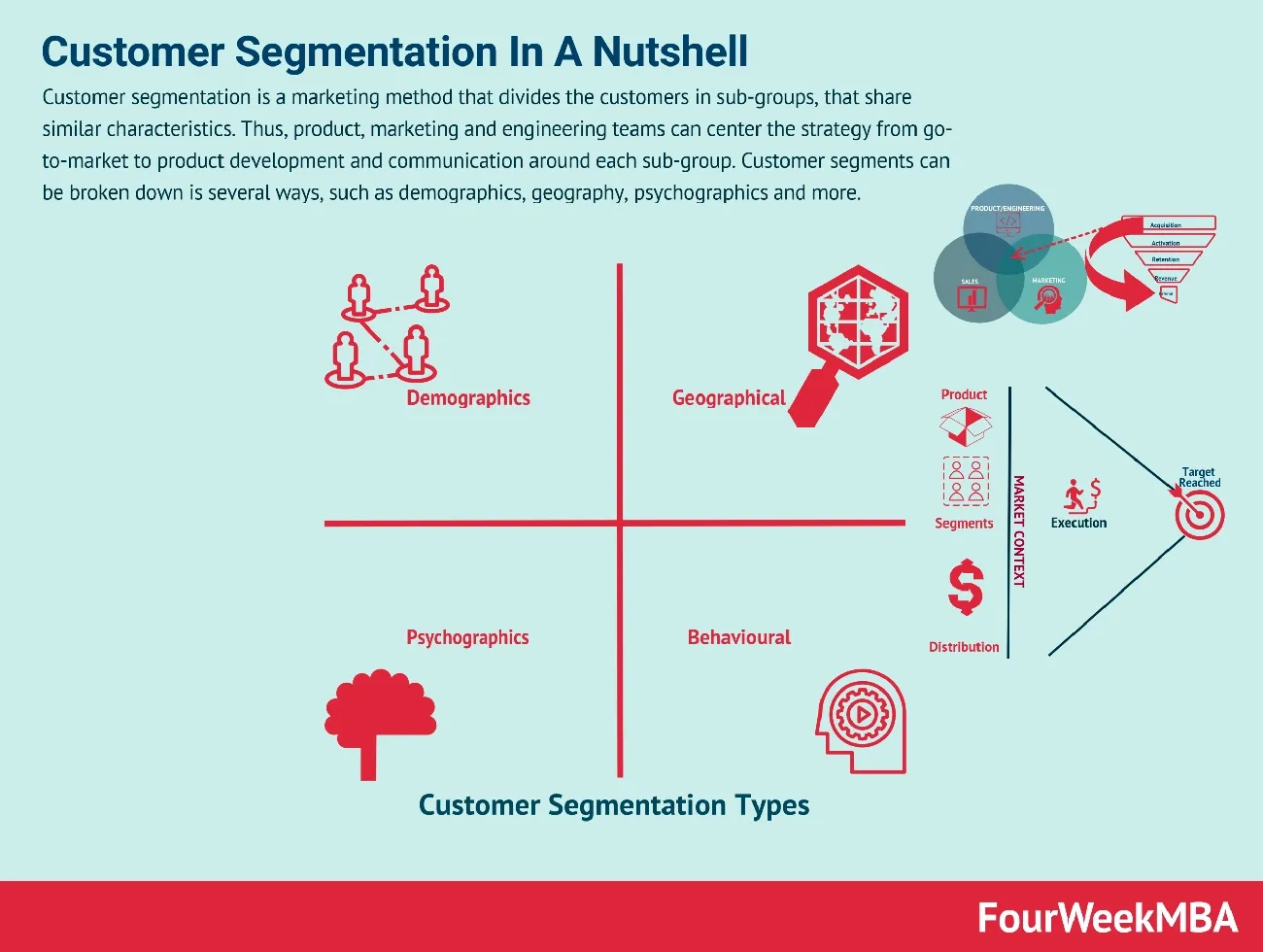
Image Source: FourWeekMBA
Income-based market divisions stand as reliable predictors of purchasing power and customer priorities. My experience with countless segmentation case studies shows how strategies matched to financial capacity lead to exceptional business results.
Income-Based Segmentation Business Goal
Companies that use income-based segmentation want to create custom offerings that line up with their customers’ financial capabilities. This approach helps businesses to:
- Create products and services that match specific customer needs based on spending power
- Create stronger connections with customers from different income groups
- Use marketing resources in the best possible way
- Build brand loyalty through relevant messaging
The main goal boils down to improving customer satisfaction while supporting business growth in competitive markets.
Income-Based Segmentation Strategy Used
A winning income-based segmentation splits consumers into clear groups—usually low, middle, and high-income brackets. Companies then build unique value propositions for each category to tackle specific pain points. This strategy works really well for:
- Luxury products aimed at high-income consumers
- Companies selling products at different price points
- Businesses that need better demand forecasting
Regular market research and customer feedback help companies fine-tune these approaches and stay relevant.
Income-Based Segmentation Implementation Approach
Companies gather income data through several channels:
- Customer-reported income through surveys or forms
- Analysis of buying patterns (expensive purchases hint at higher income)
- Third-party data from credit bureaus
- Demographic clues like zip codes or occupation
Companies must balance their data collection with privacy concerns and stay transparent about data usage.
Income-Based Segmentation Results Achieved
Companies using income segmentation see substantial benefits. Luxury goods maker Montblanc saw a soaring 118% increase in conversions with a Father’s Day promotion. They offered free gifts on purchases over £200—a threshold adjusted to match their wealthy target audience.
Companies also build stronger customer relationships and boost sales through individual-specific experiences tailored to different income brackets. All the same, the most successful companies balance profit goals with social responsibility and avoid practices that exclude customers.
Location-Based Segmentation
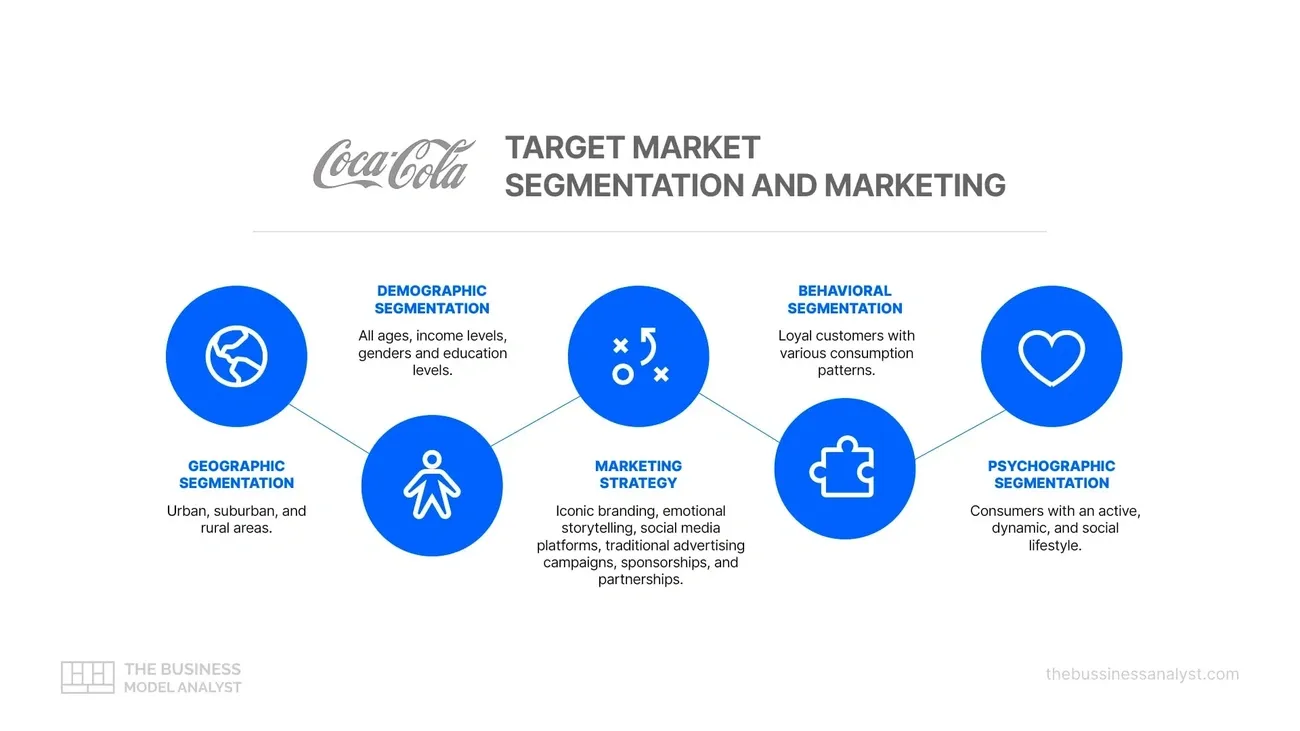
Image Source: Business Model Analyst
Geographic targeting works better than other segmentation methods to drive conversions. Power users choose this method most often at 22.6%. Location-based strategies help businesses create relevant customer experiences.
Location-Based Segmentation Business Goal
Companies use location-based segmentation to deliver content that strikes a chord with regional audiences. The main goals include:
- Marketing that fits cultural nuances and local priorities
- New market entry with region-specific strategies
- Growing market share in targeted areas
- Making messages more relevant through seasonal and climate-appropriate content
Companies also use geographic data to find unexpected traffic sources. These sources might reveal chances to expand and create new revenue streams. A good example is Slack’s Australian campaign in 2018. They launched it after they found rising demand for collaboration tools from Australian businesses.
Location-Based Segmentation Strategy Used
Smart geographic segmentation divides audiences by several location factors:
- Physical location (countries, regions, cities, neighborhoods)
- Climate and seasonal patterns
- Population density (urban, suburban, rural)
- Cultural considerations and language priorities
- Time zones to optimize engagement
DoorDash uses geographic data to show nearby restaurants to customers. Nike creates city-specific ads that speak directly to local communities. These approaches help brands fit with cultural norms in each market. Customers feel understood rather than just being sold to.
Location-Based Segmentation Implementation Approach
Teams collect geographic data through:
- IP addresses and geolocation tracking
- Billing/shipping addresses from purchases
- Mobile location services (with proper consent)
- Social media data and profile information
Organizations use Geographic Information Systems (GIS) for mapping and spatial analysis. Kraft Heinz worked with Contentful and Ninetailed to use geolocation data. They personalized homepage banners, product components, and CTAs based on user location.
Location-Based Segmentation Results Achieved
Location-based segmentation brings real results. Kraft Heinz saw 78% more conversions, 30% increased engagement, and 28% higher customer satisfaction. Timberland’s targeted campaign used audience and visitation data. They got a 6% increase in store visits. 20% of these visits happened within one day of seeing the content.
Denny’s “Bring Your Own Skillet” campaign targeted people near their restaurants. They got 25,000 more store visits. 12% of people visited within two weeks of seeing the promotion. 83% of marketers say using location data helps run better campaigns with higher engagement and response rates.
Device Type Segmentation
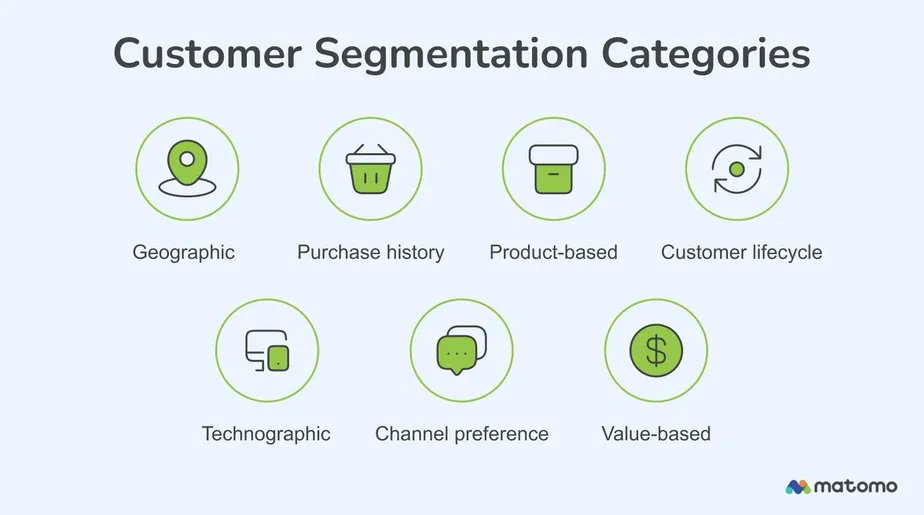
Image Source: Matomo
Technographic segmentation splits users into groups based on their device choices when interacting with your business. Digital presence grows more important each day, and understanding how people use different devices shapes their behavior. This knowledge helps create customized experiences.
Device Type Segmentation Business Goal
Companies that use device-based segmentation want to make user experiences better on every platform. The main goals include:
- Making navigation smooth whatever device people choose
- Suggesting products based on device priorities
- Putting marketing money where it works best
- Building easy-to-use interfaces for specific devices that boost involvement
This method shows how a customer’s device choice tells us about their habits and situation. To cite an instance, if 75% of visits come from mobile devices, mobile-friendly content becomes vital and marketing efforts should focus on social-first channels.
Device Type Segmentation Strategy Used
Smart device segmentation groups users by what hardware or software they like. The key information often includes:
- Type of device used (smartphone, tablet, desktop)
- Device model or brand
- Browser priorities (Chrome vs. Firefox)
- Operating system
Beyond simple grouping, successful strategies show how device usage changes substantially between different groups. Baby Boomers use tablets more (57%) than Millennials (35%). Top managers also show stronger tablet usage (43%) compared to workers (10%).
Device Type Segmentation Implementation Approach
The process works in three steps:
- Device monitoring: Tracking what devices customers use on your platform
- Creating device-responsive interfaces: Making sure everyone has a good experience
- Customizing campaigns: Shaping marketing based on how people use different devices
Most businesses use built-in analytics tools or special technographic platforms to collect this data. They must balance getting information with protecting privacy.
Device Type Segmentation Results Achieved
Device-based segmentation brings impressive improvements. One major news outlet saw many tablet users coming to their platform. They rebuilt their interface to work better for tablet reading and navigation, which gave these users an exceptional experience.
The benefits go beyond happy users. Companies see more sales, better engagement, and loyal customers when experiences match what people expect from their devices.
Cart Abandonment Segmentation
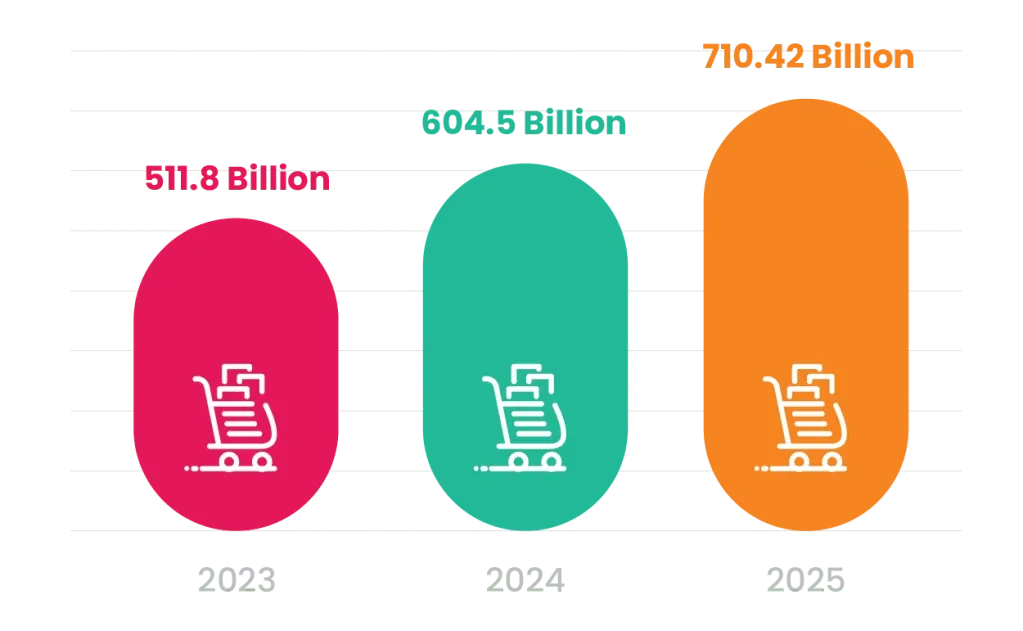
Image Source: AudienceView
Cart abandonment costs businesses USD 18 billion in lost sales annually. Research shows 70% of online shoppers abandon their carts globally. This behavioral pattern emerges clearly from segmentation case studies.
Cart Abandonment Segmentation Business Goal
Businesses need to recover lost revenue and boost conversion rates by understanding the mechanisms behind abandonment. Most cart abandonments can turn into sales because only 43% of shoppers leave due to “just browsing”. The main goal focuses on converting these near-misses into completed purchases through targeted customer outreach.
Cart Abandonment Segmentation Strategy Used
Successful businesses divide cart abandoners into specific groups:
- Value: Low vs. high cart value (high-value carts may warrant phone calls)
- Customer Type: First-time vs. returning customers (existing customers need different incentives)
- Checkout Stage: Progress level before abandonment
- Product Category: Specific product groups that sparked interest
Cart Abandonment Segmentation Implementation Approach
Automated workflows target specific segments with customized messages effectively. Businesses should send their first abandoned cart emails within 1-4 hours after abandonment while shopping memories remain fresh. Segmentation helps companies offer the right value proposition to boost conversion rates.
Cart Abandonment Segmentation Results Achieved
Case studies demonstrate remarkable success with segmentation. Samsung’s cart abandonment dropped 24% through advanced segmentation methods. Laura Ashley’s targeted exit pop-ups helped recover 17.7% of orders and saved 15.3% revenue. Abandoned cart recovery emails show impressive results with a 41.18% open rate and 50% conversion rate. These recovered orders’ average value exceeds standard purchases by 58%.
New vs. Repeat Customers
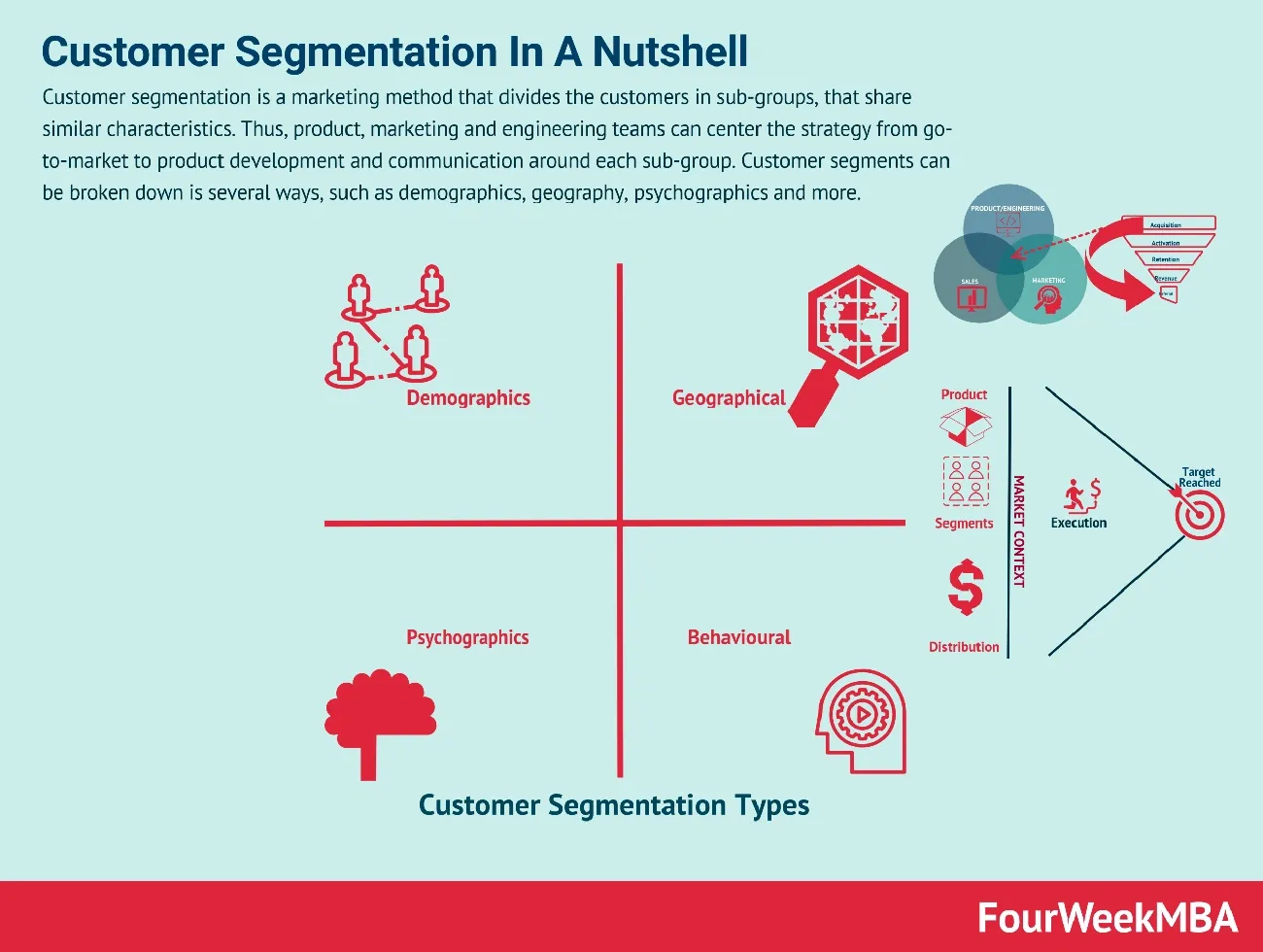
Image Source: FourWeekMBA
The behavior differences between first-time buyers and returning shoppers create great opportunities for strategic segmentation. Selling to existing customers has a 60-70% success rate, while new prospects only convert at 5-20%. These numbers show why businesses need unique approaches for both groups.
New vs. Repeat Customers Business Goal
Companies using this segmentation type want to find the right balance between getting new customers and keeping existing ones. New customer acquisition costs 16 times more than retaining current users. This makes it crucial to turn first-time buyers into repeat purchasers. Companies also need to focus on the 20% of customers who generate 80% of revenue to maintain steady growth.
New vs. Repeat Customers Strategy Used
Companies can separate these segments successfully by:
- Using welcome campaigns and educational content that new customers need
- Creating loyalty programs that boost Customer Lifetime Value by 79% within three months
- Setting up personalized product recommendations for repeat customers based on what they bought before
- Running targeted win-back campaigns with custom discounts for lapsed customers
New vs. Repeat Customers Implementation Approach
The implementation process includes:
- Looking at purchase history to identify new vs. returning status
- Building separate marketing funnels with content for each segment
- Creating personalized welcome sequences to teach first-time buyers about brand values
- Setting up loyalty programs that reward returning customers at different levels
New vs. Repeat Customers Results Achieved
Case studies show returning customers spend 300 times more than new ones. Airbnb saw a 25% increase in new bookings through their referral program. Sephora keeps customers coming back through their Beauty Insider program with tailored recommendations and special offers. Companies that focus on both segments ended up with higher lifetime value, better retention rates, and steady revenue growth.
Lifestyle-Based Segmentation
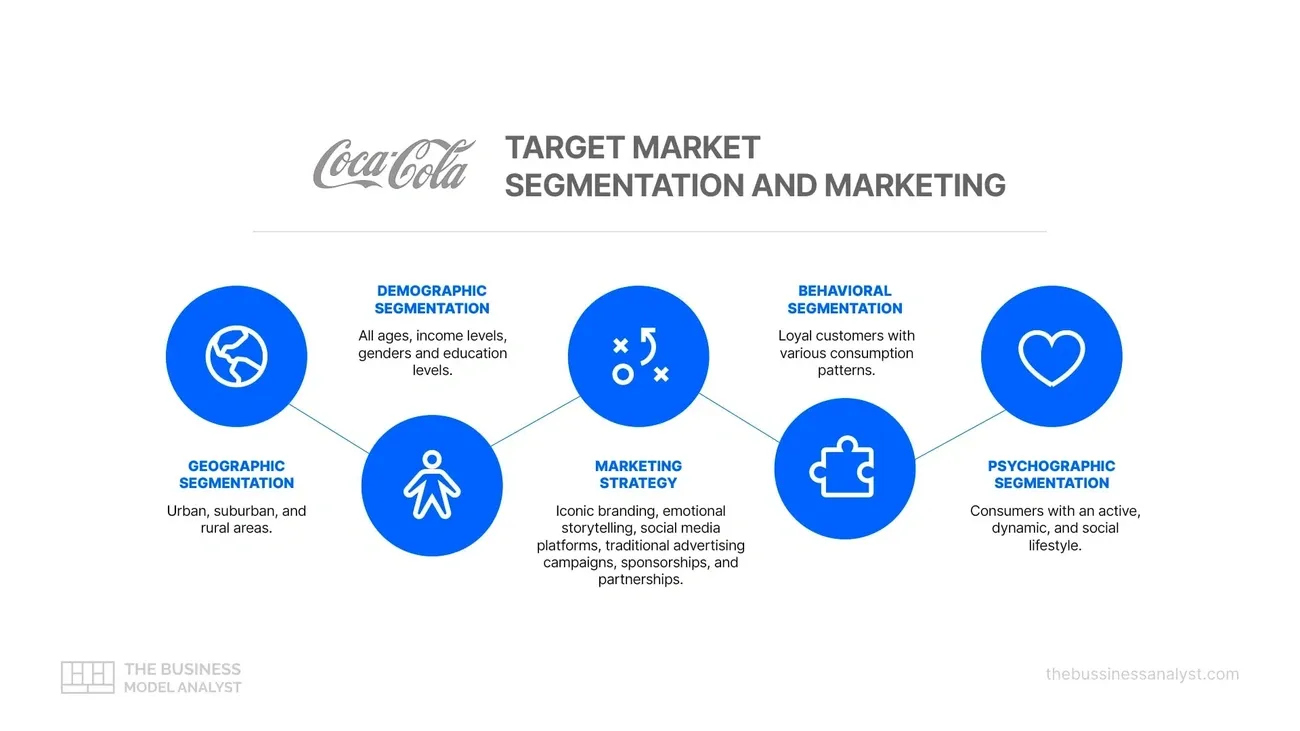
Image Source: Business Model Analyst
Lifestyle segmentation patterns give us better insights than traditional demographic approaches by looking at customers’ interests, values, and daily habits. This method is a vital part of creating tailored marketing strategies.
Lifestyle-Based Segmentation Business Goal
Companies use lifestyle segmentation to improve their customer targeting precision, retention, and marketing opportunities. Demographic methods only describe consumers, but lifestyle segmentation shows why customers make purchasing decisions. This psychographic method helps companies learn about what drives consumer behavior and encourages stronger emotional connections and brand loyalty.
Lifestyle-Based Segmentation Strategy Used
The quickest way to group customers looks at:
- Interests and hobbies
- Values and attitudes
- Spending patterns
- Life aspirations
These patterns help businesses create targeted strategies that line up with customer priorities and drive sales and participation.
Lifestyle-Based Segmentation Implementation Approach
The implementation works in eight steps:
- Define objectives clearly
- Collect relevant lifestyle data through surveys, social media, purchase history
- Analyze data to identify distinct segments
- Create detailed segment profiles
- Develop targeted strategies
- Implement and test campaigns
- Measure performance
- Refine approach continuously
Lifestyle-Based Segmentation Results Achieved
Red Bull targets “high-adrenaline” lifestyle segments through extreme sports sponsorships and builds deep emotional connections. Shawarmer’s sales jumped by 9% while customer churn dropped by 36% through occasion-based lifestyle segmentation. BeBlue shows how financial and lifestyle segmentation improves retention through tailored engagement based on transaction behavior.
Interest-Based Segmentation
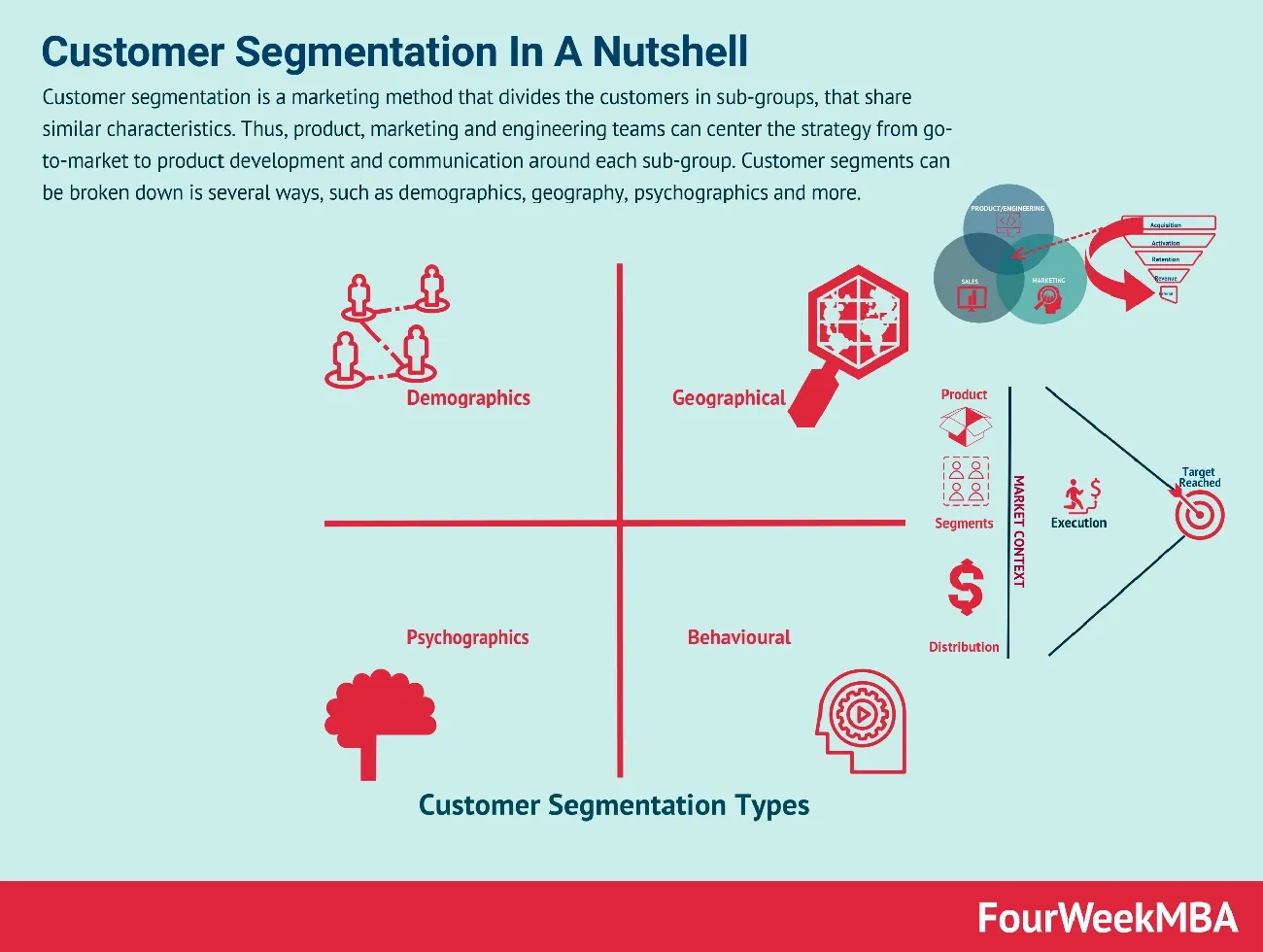
Image Source: FourWeekMBA
“By utilizing machine learning algorithms to analyze customer behavior and preferences in real-time, businesses can create highly targeted audiences and anticipate market trends more effectively.” — SuperAGI Industry Expert, Industry expert at SuperAGI, specializing in AI-driven customer segmentation
Interest-based personalization helps businesses connect with customers beyond basic demographic data. This approach gets into customers’ passions, hobbies, and priorities to create meaningful marketing experiences.
Interest-Based Segmentation Business Goal
Companies use interest-based segmentation to expand their reach beyond obvious industry connections. This method helps them find customers interested in related activities and guides them to more qualified leads. To cite an instance, a healthy snack brand might find that half their customers drive SUVs and enjoy outdoor adventures. This insight lets them create targeted campaigns that blend these interests.
Interest-Based Segmentation Strategy Used
The best strategies identify shared interests among user groups to offer customized recommendations. Food delivery apps use this method when they suggest restaurants that match their customer’s priorities. The right channels matter—43% of online mothers find brands through TV ads or search engines. Millennials differ, with 30% discovering brands through TV shows and films.
Interest-Based Segmentation Implementation Approach
The process starts with detailed audience profiling that uses consumer data to build complete interest profiles. Businesses can then identify the best marketing channels and relevant influencers. Generation Z responds particularly well to this approach—40% of them take others’ opinions seriously, and 57% keep watching vlogs.
Interest-Based Segmentation Results Achieved
Companies see better engagement and conversions when they connect with audiences through authentic, well-arranged content. A combination of reliable analytical insights with human language and transparency helps businesses create campaigns that strike a chord with today’s consumers.
Language-Based Segmentation
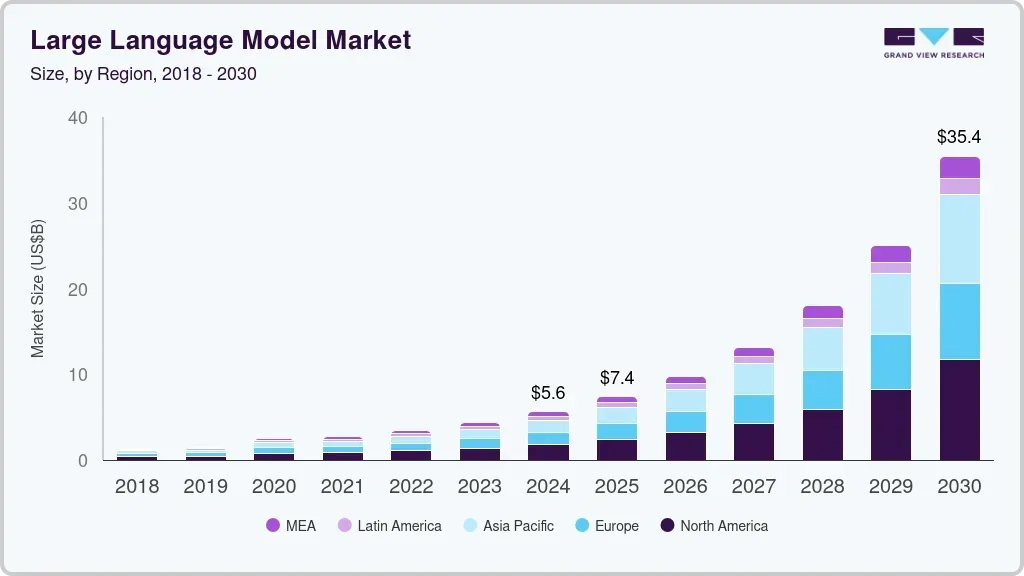
Image Source: Grand View Research
Language segmentation eliminates communication barriers and creates customized experiences in a variety of markets. Studies show that 75% of consumers prefer to buy products in their native language. This fact explains why businesses need to segment their audiences based on language priorities.
Language-Based Segmentation Business Goal
Businesses use language segmentation to grow in new markets naturally. Organizations can reach previously untapped customer bases through localized content, products, and services. The digital world makes this approach vital for global expansion.
Language-Based Segmentation Strategy Used
Smart strategies recognize that “languages are not countries”. Many companies make the mistake of using one language for an entire geographic segment. This leads to poor customer involvement—take the 30+ million Spanish speakers in the US alone. The most successful companies keep separate language mappings for each segment and use standardized locale codes for translation.
Language-Based Segmentation Implementation Approach
The implementation process works best with these key steps:
- A “mapping” system links language locale code to each segment
- Content stays separate from email segmentation for language independence
- NLP technologies help analyze customer language patterns and choices
Language-Based Segmentation Results Achieved
IndiGo airline reached more customers and kept them longer after targeting eight Indian languages in 2019. Vodafone New Zealand launched Red Connect with dedicated Mandarin/Cantonese speaking teams that improved customer experience significantly. The ‘Share a Coke’ campaign by Coca-Cola featured popular names from countries worldwide and showed how global language targeting works effectively.
Traffic Source Segmentation
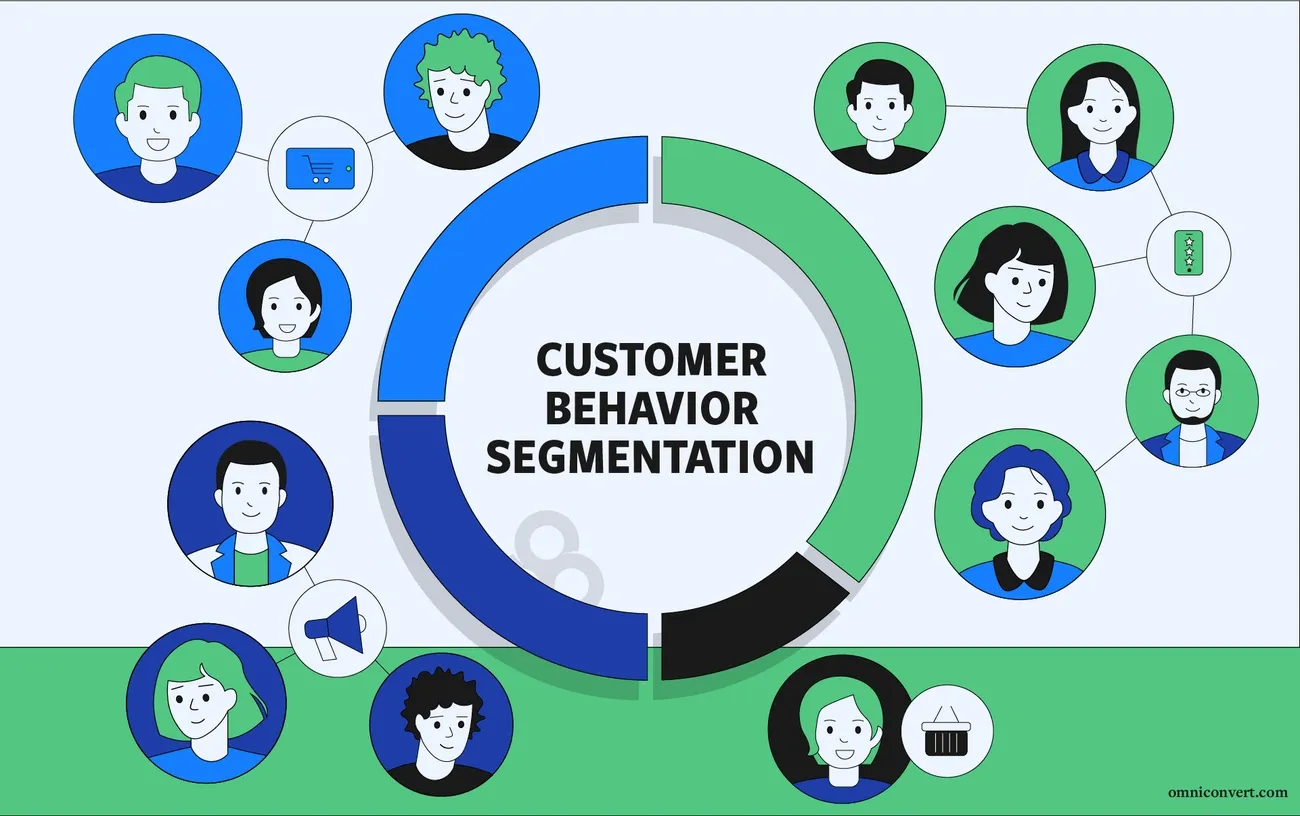
Image Source: Omniconvert
Businesses can optimize their marketing investments by understanding how each channel performs through traffic source segmentation. This method helps you learn where visitors come from and gives great insights into acquisition paths and user priorities.
Traffic Source Segmentation Business Goal
Companies that segment traffic sources want to identify their most valuable visitor channels. The main goals include finding popular platforms among target audiences, optimizing marketing budgets, preventing invalid traffic, and evaluating high-quality traffic sources. Companies can allocate their resources better toward channels that generate the best returns with this detailed understanding.
Traffic Source Segmentation Strategy Used
The best strategies group traffic based on these acquisition channels:
- Search engines (organic and paid)
- Social media platforms
- Referral links from external websites
- Direct traffic
- Email campaigns
Companies can make smart decisions by analyzing these sources. To cite an instance, when businesses see 40% of visitors coming through Instagram Ads compared to just 5% from Facebook—at the same ad cost—they can shift their budget to better-performing platforms.
Traffic Source Segmentation Implementation Approach
The implementation process includes:
- Setting up traffic channels in analytics platforms
- Using UTM parameters to track campaigns accurately
- Creating custom campaigns in Google Analytics to monitor social media performance
- Reviewing acquisition reports to spot traffic patterns
Many businesses use built-in tools like Google Analytics and Google Search Console as affordable ways to track attribution.
Traffic Source Segmentation Results Achieved
Case studies show notable differences in conversion rates from different traffic sources. B2B organic search traffic converts at 2.6%, which beats paid search (1.5%) and direct traffic (1.9%). B2C organic social leads with the highest conversion rate at 2.4%. Healthcare companies see excellent results from organic search (2.6%) and organic social (2.1%) compared to display ads (0.2%).
Browser and OS Segmentation
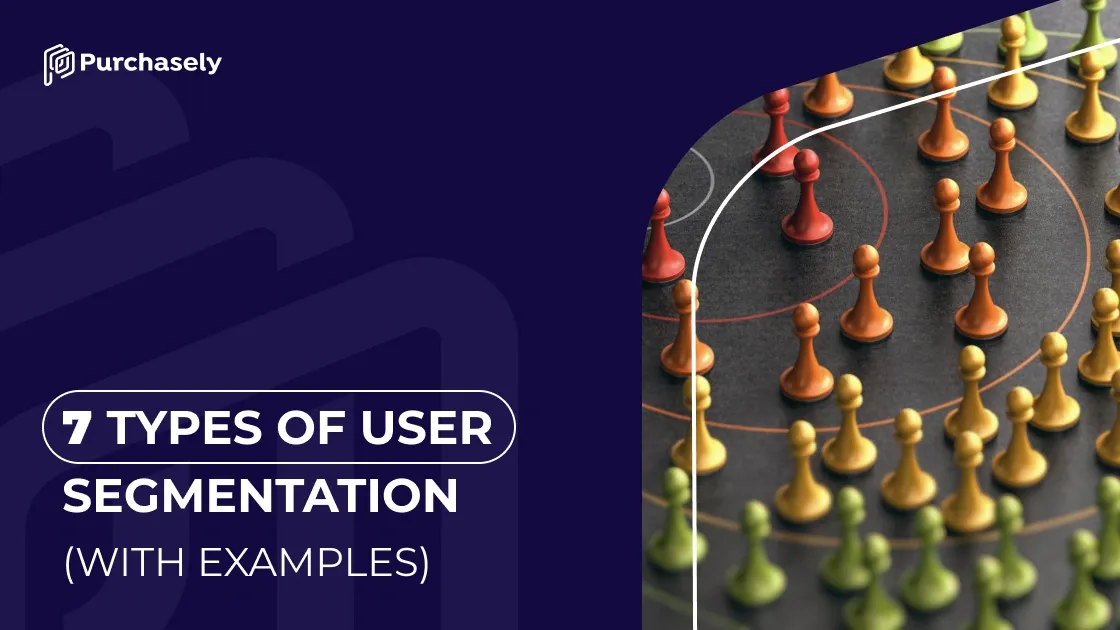
Image Source: Purchasely
Browser and operating system technical differences create unique experiences for users on digital platforms. Windows OS leads the market with a 73.50% share in 2024. Chrome remains the most popular browser as Internet Explorer continues to lose ground.
Browser and OS Segmentation Business Goal
Companies need to segment users by browser and OS to ensure their platforms work well everywhere. The team focuses on finding display problems between browsers, fixing conversion issues on specific platforms, and making sure everything runs smoothly on popular browsers. This helps businesses spot problems like checkout buttons not showing up right in Safari or other browser-specific issues that hurt sales.
Browser and OS Segmentation Strategy Used
The best strategies look at:
- Browser type (Chrome, Safari, Firefox, Edge)
- Operating system (Windows, macOS, iOS, Android)
- Browser version
- OS version
Browser and OS Segmentation Implementation Approach
Google Analytics “Browser & OS” report helps analyze browser traffic patterns. Teams often start by looking at their top browsers. Chrome might show 77% of total visits, but Safari could bring in 73% of the actual revenue.
Browser and OS Segmentation Results Achieved
Testing on platforms that generate the most revenue helps companies get real results. Teams spot low conversion rates in specific browsers and fix these issues, which leads to better overall performance.
Coupon-Lover Segmentation
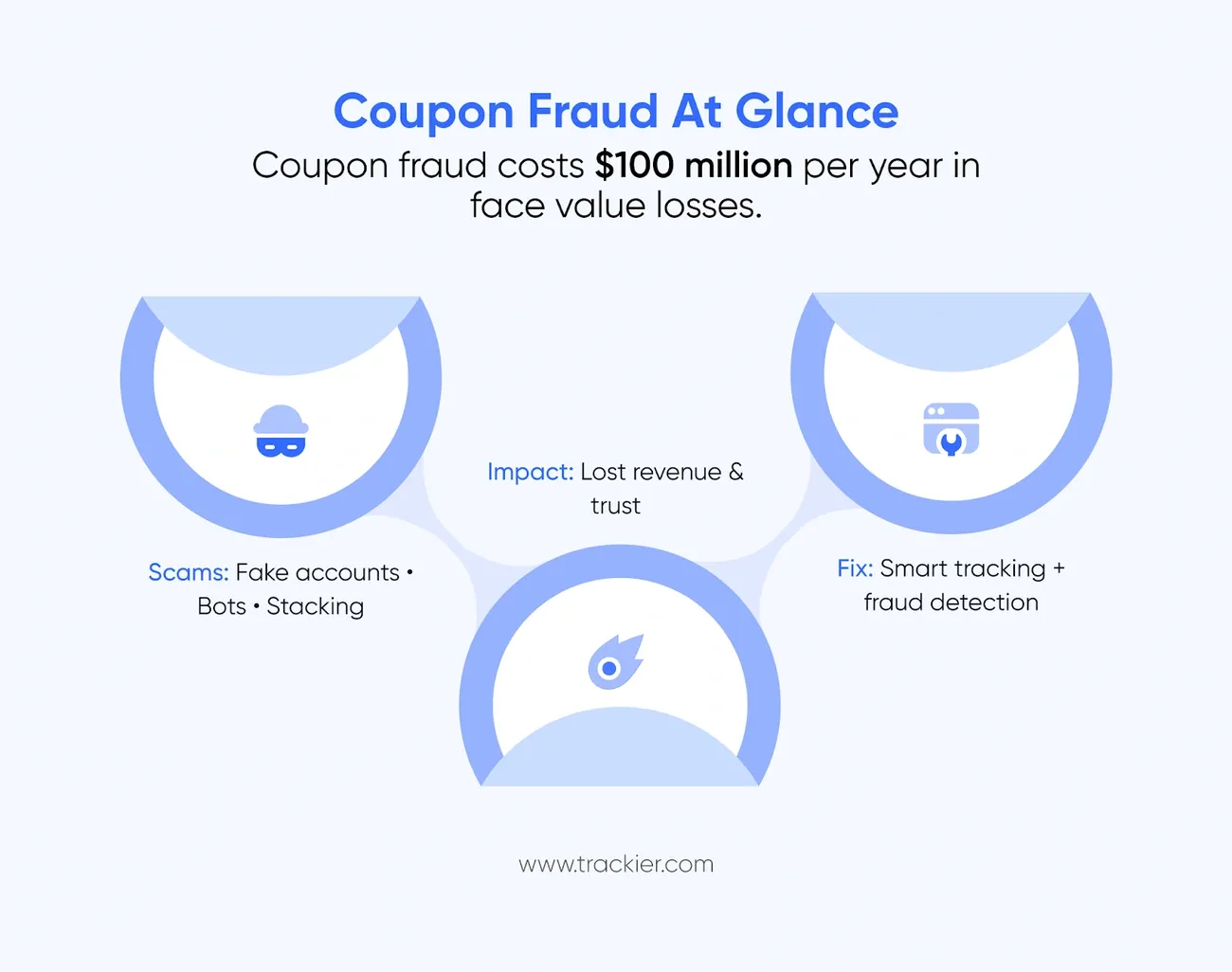
Image Source: Trackier
Businesses achieve exceptional ROI by targeting discount-seekers based on their coupon usage patterns. Studies reveal that more than 90% of U.S. consumers used at least one coupon last year, which creates powerful opportunities for market segmentation.
Coupon-Lover Segmentation Business Goal
Companies segment coupon enthusiasts to boost conversions without hurting their overall margins. These customers tend to spend more money just to get discounts, making them perfect candidates for gamified shopping experiences. This strategy helps increase immediate sales through targeted discounts, builds retention with customized offers, and optimizes marketing budgets by finding discount-sensitive audiences.
Coupon-Lover Segmentation Strategy Used
Smart strategies focus on customers who regularly use promotional codes. These “coupon lovers” show a pattern where they use a discount code with every purchase. Sephora excels at this approach by creating distinct customer segments that receive different offers based on their spending levels.
Coupon-Lover Segmentation Implementation Approach
The implementation process requires:
- Analyzing order history to find customers with 1:1 ratios of coupons to orders
- Excluding occasional coupon users to keep the segment pure
- Using customer data platforms to create dynamic segments based on user characteristics
Coupon-Lover Segmentation Results Achieved
Companies see significant benefits from this approach. Targeted coupon campaigns stimulate growth as 62% of consumers actively search for promo codes before buying. Well-segmented coupon strategies lead to higher redemption rates, better customer-brand relationships, and an exclusive shopping experience.
Value-Based Segmentation
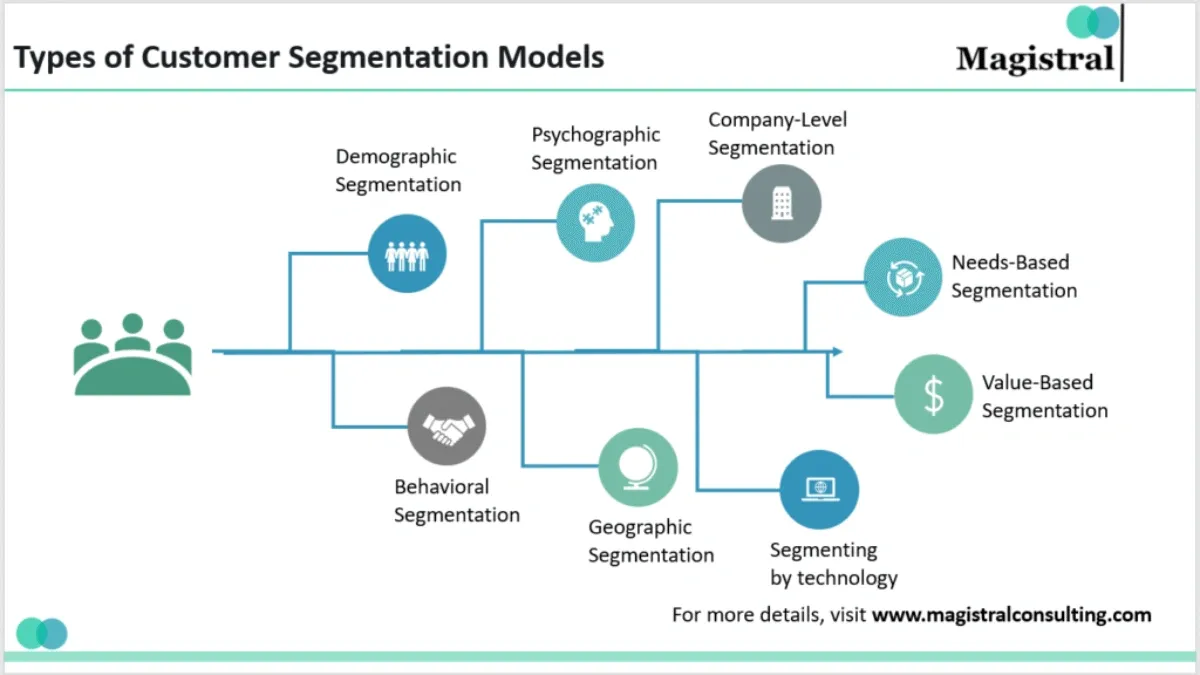
Image Source: Magistral Consulting
“Value-based segmentation is not about neglecting lower-value customers; it’s about optimizing resource allocation.” — Grassroots Creative Agency, Customer segmentation strategists and consultants
Customer value determines their priority in value-based segmentation models. Companies can allocate resources better by reviewing each customer’s financial contribution to the business.
Value-Based Segmentation Business Goal
Companies want to maximize returns on marketing investments through value segmentation. Less than half of the customer base cares about value versus cost, according to nearly two-thirds of executives. Over 70% of these executives see the value-oriented segment as vital to meeting growth targets. The main goal focuses on finding high-value clients to give them better service, resources, and tailored attention.
Value-Based Segmentation Strategy Used
Successful strategies rely on three core components:
- Business value – Measures direct customer contribution through transactions, average purchase size, or customer lifetime value
- Engagement value – Shows indirect worth through marketing interactions and content involvement
- Cost to service – Reviews acquisition and maintenance costs to determine overall profitability
Value-Based Segmentation Implementation Approach
Analysis of purchasing patterns reveals different value levels. Many companies create “value triangles” that divide customers into tiers based on revenue contribution. One organization found that their enterprise tier made up only 12% of customers but generated 60% of revenue. Companies tag customers in databases for targeted communications after identifying segments.
Value-Based Segmentation Results Achieved
The results show clear benefits – companies report better customer retention rates, higher sales, and improved revenue growth through tailored experiences. Value segmentation helps turn prospects into customers by creating tailored experiences throughout the value chain. Companies can move customers between segments effectively to boost business gains.
Customer Lifecycle Segmentation
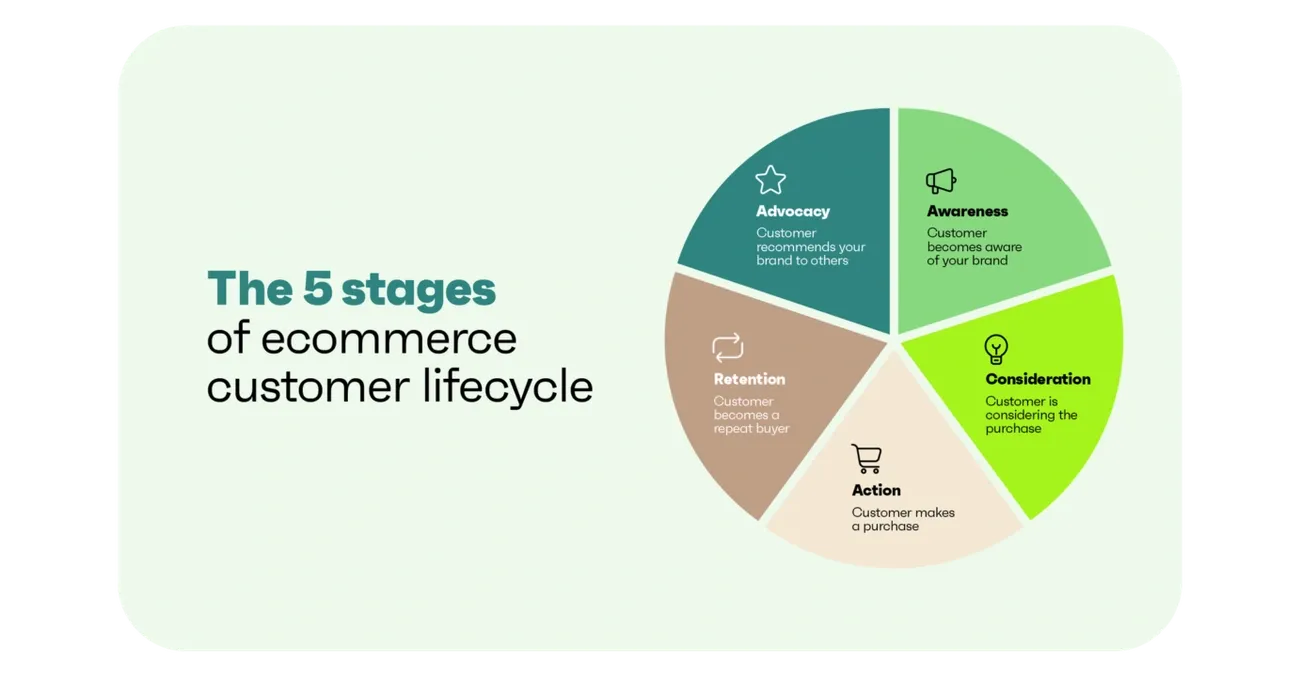
Image Source: Omnisend
Customer relationships and their timing create the foundation for lifecycle segmentation. Studies show that grouping customers by their experience stages rather than demographics helps businesses send relevant messages at crucial moments.
Customer Lifecycle Segmentation Business Goal
We improved retention by recognizing differences in customer experiences. Companies want to understand their customers’ position – from first-time browsers to loyal promoters – and create individual-specific experiences that match their current relationship stage. Teams can focus better with targeted campaigns, and 80% of marketers report improved performance through such personalization.
Customer Lifecycle Segmentation Strategy Used
Successful strategies identify different stages like new visitors, active users, at-risk customers, lapsed users, and power users/promoters. Behavior-driven segmentation helps businesses create meaningful touchpoints when they welcome new subscribers, thank recent buyers, or reconnect with lapsed customers. This approach recognizes that new trial users need simple guidance, while power users look for advanced insights.
Customer Lifecycle Segmentation Implementation Approach
The implementation process has three main steps: identifying lifecycle stages, creating behavior-based segments, and setting up automated personalized messaging. Businesses track metrics like login frequency, session duration, and purchase behavior. Many companies use customer lifecycle software to analyze data and automate marketing campaigns.
Customer Lifecycle Segmentation Results Achieved
Lifecycle segmentation creates measurable results when done right. Sephora’s Beauty Insider program uses purchase history to segment customers and keeps buyers coming back through personalized recommendations. HBO Max now offers 40% savings on annual plans to attract new customers who might question subscription costs.
Comparison Table
| Segmentation Type | Main Goal | Key Strategy Elements | Implementation Approach | Notable Results |
| Gender-Based | Create individual-specific experiences that involve customers and build loyalty | – Weekend vs. weekday patterns analysis – Channel-specific behaviors – Promotion effectiveness | – Getting gender data through registrations – Combining with behavioral analytics – A/B testing message variations | – Female leads show 20% higher lifetime value – Female conversion rates 22% higher on weekends – Male conversion rates 40% higher on weekdays |
| Age-Based | Match products and marketing to life-stage needs | – Life stages division – Cultural influences – Technology adoption patterns | – Picking the right communication channels – Creating age-specific messages – Platform-specific campaigns | – Boomers control 53% of US wealth – Better engagement and conversion rates |
| Income-Based | Build custom offerings that fit customers’ financial capabilities | – Low, middle, high-income brackets – Value propositions for each category – Need forecasting | – Self-reported income data – Purchase behavior analysis – Third-party data | Montblanc achieved 118% lift in conversions with targeted threshold offers |
| Location-Based | Create content that strikes a chord with regional audiences | – Physical location – Climate patterns – Cultural considerations – Time zones | – IP address tracking – Billing/shipping addresses – Mobile location services | – Kraft Heinz: 78% more conversions, 30% increased engagement – Denny’s: 25,000 increased store visits |
| Device Type | Make user experiences better across different platforms | – Device type categorization – Browser priorities – Operating system analysis | – Device monitoring – Building responsive interfaces – Customizing campaigns | Higher conversion rates and increased engagement (specific percentages not mentioned) |
| Cart Abandonment | Get back potential revenue and boost conversion rates | – Value-based segmentation – Customer type analysis – Checkout stage tracking | – Efficient workflows – Custom messages within 1-4 hours | – Samsung reduced abandonment by 24% – 41.18% email open rate – 50% conversion rate |
| New vs. Repeat | Balance new customer acquisition with retention | – Welcome campaigns – Loyalty programs – Custom recommendations | – Purchase history analysis – Separate marketing funnels – Tiered rewards | – Returning customers spend 300x more than new ones – Airbnb: 25% increase in new bookings |
| Lifestyle-Based | Make customer targeting more precise and improve retention | – Interests and hobbies – Values and attitudes – Spending patterns | Eight-step process from goal definition to continuous refinement | Shawarmer increased sales by 9% while reducing churn by 36% |
| Interest-Based | Grow reach beyond obvious industry connections | – Common interests identification – Channel priorities – Audience profiling | – Detailed audience profiling – Consumer data analysis – Influencer identification | Increased engagement and conversions (specific percentages not mentioned) |
| Language-Based | Enter new markets naturally | – Language locale mapping – Content separation – NLP technologies | – Language mapping maintenance – Email segmentation separation – Content localization | 75% of consumers prefer buying in their native language |
| Traffic Source | Find most valuable visitor channels | – Search engines – Social media – Referral links – Direct traffic | – UTM parameter tracking – Custom campaign creation – Acquisition report analysis | B2B organic search converts at 2.6% vs paid search at 1.5% |
| Browser and OS | Make sure everything works well across all platforms | – Browser type – Operating system – Version tracking | – Google Analytics tracking – Platform-specific testing – Performance monitoring | Windows OS dominated with 73.50% market share |
| Coupon-Lover | Increase conversions without hurting margins | – Purchase pattern analysis – Discount code usage tracking – User attribute analysis | – Order history filtering – Sporadic user removal – Dynamic segmentation | 90% of U.S. consumers used at least one coupon last year |
| Value-Based | Get the most from marketing investments | – Business value – Engagement value – Cost to service | – Value triangle creation – Customer database tagging – Targeted communications | Enterprise tier (12% of customers) generated 60% of revenue |
| Customer Lifecycle | Build retention through stage-specific targeting | – Experience stage identification – Behavior tracking – Engagement metrics | – Key lifecycle stage identification – Behavior-based segmentation – Automated messaging | 80% of marketers report better performance through personalization |
Conclusion
Segmentation remains one of the most powerful tools businesses can use to grow in 2025 and beyond. Our analysis of 15 ground case studies shows how targeted approaches deliver measurable results in businesses of all types.
Businesses achieve the best results when they look beyond simple demographics and consider behavior, psychology, and technology. Samsung reduced cart abandonment by 24% through advanced segmentation. Kraft Heinz saw 78% more conversions by personalizing based on location.
Different segments need different approaches. A customer’s spending increases 300 times after the first purchase, but each group needs messages that match their relationship stage. Gender analysis shows women’s lifetime value is 20% higher, which makes them key targets to consider for long-term strategies.
Without doubt, technology has changed how we segment customers. AI tools help businesses analyze customer behavior live and create targeted audiences that weren’t possible before. This precision builds stronger customer relationships, increases conversion rates, and grows revenue.
Success comes from mixing multiple segmentation methods based on your business goals. Companies with soaring wins blend demographic, behavioral, and psychological insights to build complete customer profiles.
Many ask where to start with segmentation. Begin by studying your most valuable customers’ shared traits. Pick one segmentation method based on what you learn, then add more over time. Note that good segmentation needs constant updates as customer priorities change.
Companies that adopt smart segmentation will outperform those using broad, untargeted approaches. The results are clear – personalization builds loyalty, boosts conversions, and accelerates your bottom line.
Key Takeaways
These 15 real-world segmentation case studies reveal how strategic customer targeting drives measurable business growth across industries and customer types.
• Behavioral segmentation outperforms demographics: Companies like Samsung reduced cart abandonment by 24% using advanced behavioral patterns rather than basic demographic data.
• Multi-dimensional approaches yield highest returns: Businesses combining demographic, behavioral, and psychographic insights achieve stronger customer relationships and higher conversion rates.
• Returning customers drive exponential value: Existing customers spend 300 times more than new prospects, making retention-focused segmentation critical for sustainable growth.
• Location-based personalization delivers immediate results: Kraft Heinz achieved 78% more conversions and 30% increased engagement through geographic targeting strategies.
• AI-powered real-time segmentation creates competitive advantage: Modern tools enable businesses to analyze customer behavior instantly, creating highly targeted audiences that weren’t possible before.
The most successful companies don’t rely on single segmentation methods but strategically combine multiple approaches based on their specific business objectives. Start by analyzing your most valuable customers’ common characteristics, implement one targeted approach, then gradually expand into additional dimensions for maximum impact.
FAQs
Q1. What are some real-world examples of successful customer segmentation? Companies like Samsung reduced cart abandonment by 24% using advanced behavioral segmentation, while Kraft Heinz achieved 78% more conversions through location-based personalization. These cases demonstrate how targeted approaches can deliver measurable results across industries.
Q2. How is sales expected to evolve by 2025? By 2025, over half of large transactions are predicted to occur through digital self-service channels. This shift doesn’t mean buyers don’t want assistance, but rather that they prefer accessing information at their own pace. Businesses will need to adapt their sales strategies accordingly.
Q3. What surprising facts should businesses know about sales? 80% of sales require 5 or more follow-ups, yet 44% of salespeople give up after just one attempt. Additionally, 91% of customers would provide referrals, but only 11% of sales representatives ask for them. These statistics highlight opportunities for improving sales processes and customer engagement.
Q4. How does customer segmentation impact business growth? Effective segmentation strategies have been shown to significantly boost business growth. For instance, returning customers spend approximately 300 times more than new ones, emphasizing the importance of retention-focused segmentation for sustainable growth and increased revenue.
Q5. What role does technology play in modern customer segmentation? AI-powered tools now enable businesses to analyze customer behavior in real-time, creating highly targeted audiences that weren’t possible before. This technological advancement allows for more precise segmentation, leading to stronger customer relationships, higher conversion rates, and improved revenue growth.
“If you found this guide useful, join my free Business Intelligence Edge newsletter for weekly, practical data-driven insights to grow your business.”

